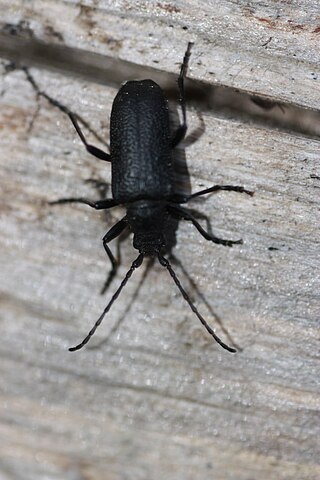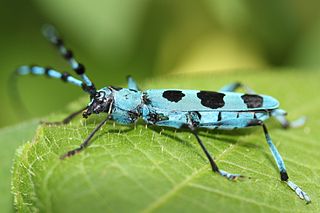
Necydalinae is a small subfamily of the longhorn beetle family (Cerambycidae), historically treated as a tribe within the subfamily Lepturinae, but recently recognized as a separate subfamily. These beetles are unusual for cerambycids, in that the elytra are quite short; they are thus rather similar in appearance to rove beetles, though most are actually bee or wasp mimics.
Neanthophylax mirificus is a species of Long-Horned Beetle in the beetle family Cerambycidae. It is found in North America, Costa Rica, and Mexico.
Neanthophylax subvittatus is a species of Long-Horned Beetle in the beetle family Cerambycidae. It is found in United States.

Neanthophylax tenebrosus is a species in the longhorn beetle family Cerambycidae, found in United States. The adult beetles feed on mountain hemlock and red fir.

Dorcasominae is a subfamily in the longhorn beetle family Cerambycidae. There are about 14 genera and more than 30 described species in Dorcasominae, found mainly in Asia and Africa. These genera are sometimes considered members of the tribe Dorcasomini, which would be the only tribe of this subfamily. This classification is in accordance with the TITAN Cerambycidae database, Catalogue of Life, and Photographic Catalog of the Cerambycidae of the Old World. It is similar to that of Bouchard et al. in "Family-group names in Coleoptera", 2011.

Neanthophylax is a genus in the longhorn beetle family Cerambycidae. There are at least four described species in Neanthophylax.

Achrysonini is a tribe of Long-Horned Beetles in the beetle family Cerambycidae. There are more than 20 genera and 50 described species in Achrysonini. They are found mainly in the Americas, but also in Europe, Asia, and Africa.

Criodion is a genus of Long-Horned Beetles in the beetle family Cerambycidae. There are about 11 described species in Criodion.
Plocaederus is a genus of Long-Horned Beetles in the beetle family Cerambycidae. This genus has a single species, Plocaederus bellator. It is known from the South American countries Brazil, Ecuador, Guyana, French Guiana, Paraguay, and Suriname.

Neoclytus is a genus of beetles in the family Cerambycidae. They measure 4-20 mm. There are 93 species in the New World.

Compsocerini is a tribe of beetles in the subfamily Cerambycinae, containing the following genera:
Hylorus is a genus of Long-Horned Beetles in the beetle family Cerambycidae. This genus has a single species, Hylorus armatus. It is found in Brazil.
Upindauara is a genus of Long-Horned Beetles in the beetle family Cerambycidae. This genus has a single species, Upindauara bella, found in Brazil.

Pronuba is a genus of long-horned beetles in the family Cerambycidae. There are about five described species in Pronuba, found in Central and South America.

Lautarus is a genus in the longhorn beetle family family Cerambycidae. This genus has a single species, Lautarus concinnus. It is known from southern Argentina and Chile.
Neoclytus pubicollis is a species of beetle in the family Cerambycidae. It was described by Fisher in 1932.
Cathexis is a genus of Long-Horned Beetles in the beetle family Cerambycidae. There are at least two described species in Cathexis, found in Brazil and Argentina.
Eupogonius pubicollis is a species of beetle in the family Cerambycidae. It was described by Melzer in 1933. It is known from Honduras and Panama.
Scaposerixia pubicollis is a species of beetle in the family Cerambycidae. It was described by Pic in 1932.

Peribasis pubicollis is a species of beetle in the family Cerambycidae. It was described by Francis Polkinghorne Pascoe in 1866. It is known from Singapore, Borneo, Bhutan and Malaysia.









